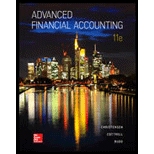
Concept explainers
a.
Sale of subsidiary sales by parent:When parent sales share of subsidiary, parent has to recognize a gain or loss on the difference between selling price and the change in the carrying amount of its investment. From consolidation viewpoint, when subsidiary reacquires its share from parent, the transaction represents an internal transfer and does not give rise to a gain or loss.
Because the gain or loss will be eliminated in consolidation process. A better approach is for the parent to adjust additional paid-in capital rather than record gain or loss on the transaction.
The consolidation entry needed to complete consolidated
b.
Sale of subsidiary sales by parent:When parent sales share of subsidiary, parent has to recognize a gain or loss on the difference between selling price and the change in the carrying amount of its investment. From consolidation viewpoint, when subsidiary reacquires its share from parent, the transaction represents an internal transfer and does not give rise to a gain or loss.
Because the gain or loss will be eliminated in consolidation process. A better approach is for the parent to adjust additional paid-in capital rather than record gain or loss on the transaction.
The preparation of consolidated balance sheet worksheet
Want to see the full answer?
Check out a sample textbook solution
Chapter 9 Solutions
Advanced Financial Accounting
- Can you help me solve this financial accounting question using the correct financial procedures?arrow_forwardHow can I solve this financial accounting problem using the appropriate financial process?arrow_forwardI need help with this general accounting problem using proper accounting guidelines.arrow_forward
- Please provide the solution to this financial accounting question with accurate financial calculations.arrow_forwardPlease explain the solution to this general accounting problem using the correct accounting principles.arrow_forwardCan you explain the correct methodology to solve this general accounting problem?arrow_forward
- Can you solve this financial accounting question with the appropriate financial analysis techniques?arrow_forwardI need the correct answer to this general accounting problem using the standard accounting approach.arrow_forwardPlease give me true answer this financial accounting questionarrow_forward

 AccountingAccountingISBN:9781337272094Author:WARREN, Carl S., Reeve, James M., Duchac, Jonathan E.Publisher:Cengage Learning,
AccountingAccountingISBN:9781337272094Author:WARREN, Carl S., Reeve, James M., Duchac, Jonathan E.Publisher:Cengage Learning, Accounting Information SystemsAccountingISBN:9781337619202Author:Hall, James A.Publisher:Cengage Learning,
Accounting Information SystemsAccountingISBN:9781337619202Author:Hall, James A.Publisher:Cengage Learning, Horngren's Cost Accounting: A Managerial Emphasis...AccountingISBN:9780134475585Author:Srikant M. Datar, Madhav V. RajanPublisher:PEARSON
Horngren's Cost Accounting: A Managerial Emphasis...AccountingISBN:9780134475585Author:Srikant M. Datar, Madhav V. RajanPublisher:PEARSON Intermediate AccountingAccountingISBN:9781259722660Author:J. David Spiceland, Mark W. Nelson, Wayne M ThomasPublisher:McGraw-Hill Education
Intermediate AccountingAccountingISBN:9781259722660Author:J. David Spiceland, Mark W. Nelson, Wayne M ThomasPublisher:McGraw-Hill Education Financial and Managerial AccountingAccountingISBN:9781259726705Author:John J Wild, Ken W. Shaw, Barbara Chiappetta Fundamental Accounting PrinciplesPublisher:McGraw-Hill Education
Financial and Managerial AccountingAccountingISBN:9781259726705Author:John J Wild, Ken W. Shaw, Barbara Chiappetta Fundamental Accounting PrinciplesPublisher:McGraw-Hill Education





